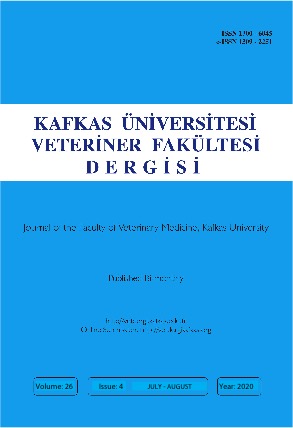
This journal is licensed under a Creative Commons Attribution-NonCommercial 4.0 International License
Kafkas Üniversitesi Veteriner Fakültesi Dergisi
2020 , Vol 26 , Issue 4
Serovars, Antimicrobial Susceptibility and Molecular Characteristics of Haemophilus parasuis Isolates in Southern China
1Yingdong College of Biology and Agriculture, Shaoguan University, Shaoguan 512005, CHINA2Joint Laboratory of Animal Infectious Diseases Diagnostic Center-Harbin Veterinary Research Institute of Chinese Academy of Agriculture Science, Shaoguan University, Shaoguan 512005, CHINA DOI : 10.9775/kvfd.2019.23587 This study analyzed the characteristics of 133 Haemophilus parasuis isolates in southern China. These isolates belonged to eleven serovars (1, 2, 4-10, 13 and 15) with 12.0% of them being characterised as non-typable. A relatively high level in resistance was encountered for trimethoprim + sulfamethoxazole (89.9%), tetracycline (75.3%), amoxicillin (69.1%), streptomycin (63.6%), carbenicillin (60.2%), kanamycin (46.6%) and ampicillin (45.6%). A total of 60% of the isolates were negative for group 1 virulence-associated autotransporters (vtaA). All group 1 vtaA negative isolates fell into polyacrylamide gel electrophoresis (PAGE) type I, while all group 1 vtaA positive isolates were classified as PAGE type II. The results of Multi-locus sequence typing (MLST) indicated a high degree of variation, 45 isolates in the study were assigned into 31 sequence types with 28 of these being new (not found in the MLST database). Antimicrobial resistance was observed in every serovar, there was no statistically significant correlation between the antimicrobial resistance and the serovars. The isolates allocated to clade 2 (based on MLST target sequences) showed the molecular characteristics of highly pathogenic strains in whole-cell protein profiling, vtaA groups 1, superoxide dismutase (sodA) sequence and MLST. Keywords : Haemophilus parasuis, Antimicrobial susceptibility, MLST, PAGE, vtaA, SodA










